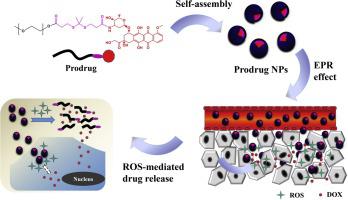Colloids and Surfaces B: Biointerfaces ( IF 5.4 ) Pub Date : 2020-06-25 , DOI: 10.1016/j.colsurfb.2020.111223 Qingqing Pan 1 , Xin Deng 1 , Wenxia Gao 2 , Jing Chang 3 , Yuji Pu 1 , Bin He 1

|
With the utilization of high concentration reactive oxygen species (ROS) in tumor microenvironment, PEG-doxorubicin (PEG-DOX) prodrug was synthesized via a thioketal moiety as the linker, which was ROS cleavable to trigger DOX release from the self-assembled prodrug nanoparticles. The in vitro ROS sensitivity of prodrug nanoparticles (NPs) was investigated in Fenton agent and H2O2, and the disassembly of NPs was more sensitive to Fenton reagent. After internalized in HepG2 cells via endocytosis, the cellular ROS consuming test revealed intracellular DOX release. The pharmacokinetics and biodistribution study demonstrated that the in vivo elimination of NPs was significantly improved and the NPs were passively targeted to tumor tissues via EPR effect. The ROS-responsive prodrug NPs exhibited excellent antitumor activity in HepG2 tumor-bearing nude mice, remarkably induced tumor cells apoptosis and reduced the systemic toxicity of DOX. Our study revealed the ROS responsive prodrug nanoparticle is an effective strategy to fabricate nanomedicine for cancer chemotherapy.
中文翻译:

ROS触发硫缩酮部分的裂解,以解离前药纳米颗粒进行化学治疗。
利用肿瘤微环境中的高浓度活性氧(ROS),通过硫代缩酮部分作为接头合成了PEG-阿霉素(PEG-DOX)前药,该ROS可被裂解以触发DOX从自组装前药纳米颗粒中释放。在Fenton剂和H 2 O 2中研究了前药纳米颗粒(NPs)的体外ROS敏感性,而NP的拆卸对Fenton试剂更敏感。通过内吞作用进入HepG2细胞内后,细胞ROS消耗测试显示细胞内DOX释放。药代动力学和生物分布研究表明,NPs的体内消除作用得到了显着改善,并且通过EPR效应将NPs被动地靶向了肿瘤组织。ROS响应前药NPs在荷HepG2荷瘤裸鼠中表现出优异的抗肿瘤活性,显着诱导肿瘤细胞凋亡并降低DOX的全身毒性。我们的研究表明,ROS反应性前药纳米颗粒是制备用于癌症化疗的纳米药物的有效策略。











































 京公网安备 11010802027423号
京公网安备 11010802027423号